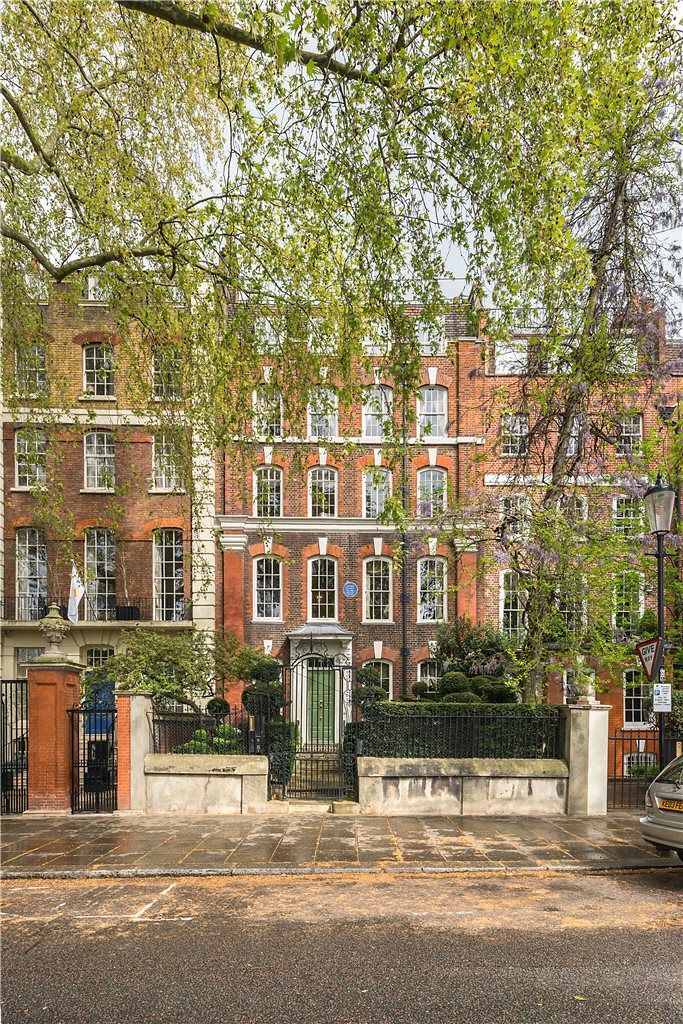©By Cheryl Bolen
Cheyne Walk is a rarity in London: a street of lovely mansions practically on the banks of the River Thames. Located in Chelsea, the walk was originally constructed in the early 1700’s and over the centuries has been home to a Who’s Who of authors, painters, musicians, one Prime Minister, and in more recent decades, billionaires.

The street is named after Lord Cheyne who lived in the Chelsea mansion until 1712, at which time he sold it to Sir Hans Sloane. The new owner constructed individual mansions on the site. Each of the properties went all the way to the river until the Embankment was built in the nineteenth century. Since then, pedestrians can stroll in front of the houses, which still have grand views of the river. Since the stunning Albert Bridge was built of iron in 1873, the homes on Cheyne Walk also have a close-up view of the bridge.
Sloane built Numbers 19-26 between 1759 and 1765 on land that had once held a manor house belonging to Henry VIII. It’s said Elizabeth I planted trees on the site.
During the 19th century many artists and authors, including Dante Gabriel Rossetti, George Eliot, JMW Turner, Bram Stoker, and Algernon Charles Swinburne, lived here.
Sir Mark Brunel (1769-1849), who designed the Thames Tunnel, lived on Cheyne Walk, as did his more famous son, Isambard Kingdom Brunel (1806-1859), an engineering giant of the nineteenth century.
In 1886 Carlyle Mansions, a block of flats, was built on Cheyne Walk. They were named after Thomas Carlyle, whose residence was just around the corner from Cheyne Walk. The author was a lifelong resident of Chelsea. Famed authors who’ve rented flats at Carlyle Mansions (sometimes called Writers’ Block) include Henry James, T.S. Eliot, William Somerset Maugham, and James Bond’s creator, Ian Fleming, who also lived briefly at Number 124. (Flats there now average around $2 million each but can go much higher.)
Prime Minister David Llyod George (1863-1945) lived at Number 10. In the 1930s Laurence Olivier lived on Cheyne Walk, and another actor, American John Barrymore, also made his home briefly at Cheyne Walk.
Three of the Rolling Stones have called Cheyne Walk home. In the 1960s Mick Jagger lived at Number 48 with Marianne Faithful, and fellow band mate Keith Richards lived at Number 3. A later addition to the band, Ronnie Wood, lived at Number 119.
Author Ken Follett has lived at Number 92.
The houses have fences around them for privacy and locked gates, but their view of the bustling river from the upper stories has not been obstructed.
A character in one of the BBC episodes of Sherlock Holmes starring Jeremy Britt lived on Cheyne Walk. One scene depicts the home’s great river views during Victorian times. (Unfortunately, this author does not remember which episode!)

Many of the homes have been turned into flats, but there are still a number of them which have remained multi-story homes. During the past forty years, billionaires have been buying these. John Paul Getty II lived in one. Russian billionaire Roman Abramovich, who owns the Chelsea Football Club, owns Number 101. In 2015, American billionaire and former New York Mayor Michael Bloomberg paid $25 million for the house at Number 4.
The house which formerly stood at Number 128 has been demolished, and the World’s End Estate now stands on the site. The Clash front man Joe Strummer lived there.
Hopefully, no more of these historic houses will be demolished, and Cheyne Walk will remain largely as it was in the eighteenth and nineteenth centuries. —Cheryl Bolen has strolled Cheyne Walk on one of her frequent trips to England. The author of more than 40 historical novels and novellas has been writing about Georgian England for a quarter of a century. Her articles can be found both on her website, https://www.cherylbolen.com,/ or her blog https://cherylsregencyramblings.wordpress.com/. Her latest series is The Beresford Adventures, the first title of which is Lady Mary’s Dangerous Encounter.





